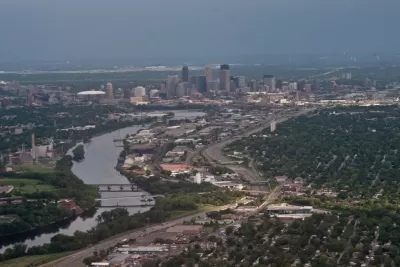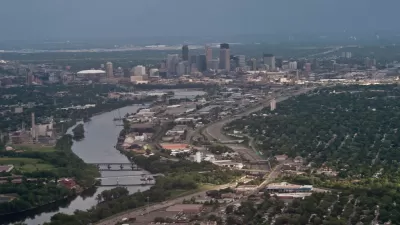A plan for 48 acres of riverfront land could make Minneapolis a leader in doing redevelopment right, argue city leaders.

The Minneapolis City Council on Friday approved a plan for the Upper Harbor Terminal, an industrial riverfront area north of downtown. Ahead of an earlier city council committee vote on the plan, Mayor Jacob Frey and Phillipe Cunningham, a member of the city council, made the case for the redevelopment project:
The sustained exclusion from opportunities afforded by the riverfront is a sad legacy that we simply must change. Done right, redevelopment of the Upper Harbor Terminal holds the opportunity to ensure that current residents benefit, that the area’s economy thrives and that the north Minneapolis riverfront is highlighted in deserving fashion.
The concept plan includes a performing arts center, green space, housing, a business center, and a utility hub. The plan, argue Frey and Cunningham, reflects an approach that ensures equity is part of the redevelopment process and demonstrates how other cities can maximize public investment while also addressing longstanding economic inequality.
"With 41 percent of the land designated for park use, plans for new employment opportunities, more affordable housing and a signature concert venue, Minneapolis has a chance to create a national model for equitable economic development that stabilizes community while expanding riverfront access," say Frey and Cunningham.
The plan has been controversial, with community and environmental advocates outlining a series of concerns about privatization of land, restricted public access to green space, and gentrification effects on surrounding neighborhoods.
Frey and Cunningham say they are committed to a collaborative planning process that will directly involve the community. "This is an undertaking of historic proportions, and part of changing history means we put north Minneapolis first and make sure North Side residents are involved in the planning process."
FULL STORY: Minneapolis development and economic equity: Upper Harbor Terminal can be a national model

Alabama: Trump Terminates Settlements for Black Communities Harmed By Raw Sewage
Trump deemed the landmark civil rights agreement “illegal DEI and environmental justice policy.”

Planetizen Federal Action Tracker
A weekly monitor of how Trump’s orders and actions are impacting planners and planning in America.

The 120 Year Old Tiny Home Villages That Sheltered San Francisco’s Earthquake Refugees
More than a century ago, San Francisco mobilized to house thousands of residents displaced by the 1906 earthquake. Could their strategy offer a model for the present?

Ken Jennings Launches Transit Web Series
The Jeopardy champ wants you to ride public transit.

BLM To Rescind Public Lands Rule
The change will downgrade conservation, once again putting federal land at risk for mining and other extractive uses.

Indy Neighborhood Group Builds Temporary Multi-Use Path
Community members, aided in part by funding from the city, repurposed a vehicle lane to create a protected bike and pedestrian path for the summer season.
Urban Design for Planners 1: Software Tools
This six-course series explores essential urban design concepts using open source software and equips planners with the tools they need to participate fully in the urban design process.
Planning for Universal Design
Learn the tools for implementing Universal Design in planning regulations.
Clanton & Associates, Inc.
Jessamine County Fiscal Court
Institute for Housing and Urban Development Studies (IHS)
City of Grandview
Harvard GSD Executive Education
Toledo-Lucas County Plan Commissions
Salt Lake City
NYU Wagner Graduate School of Public Service




























